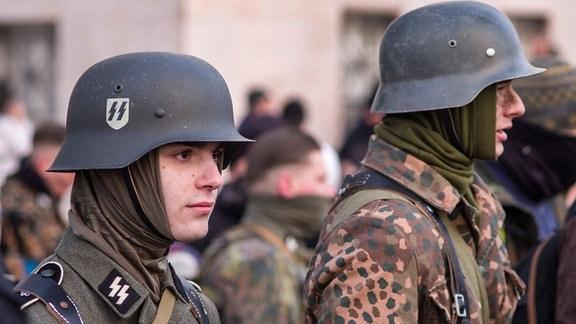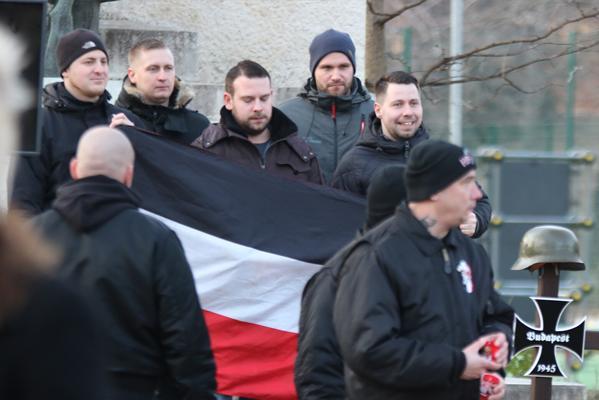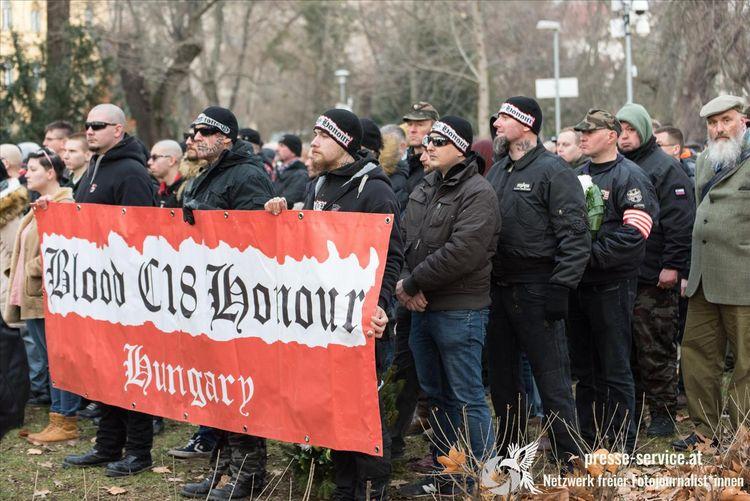Historical Revisionism, Nazi Glorification, and International Networking
Since 1997, thousands of neo-Nazis have gathered annually on February 11th in the Hungarian capital for the so-called “Day of Honor,” commemorating the attempted breakout of besieged Nazi troops in 1945. In the midst of the Red Army’s siege, seventy thousand German SS and Wehrmacht soldiers, along with Hungarian collaborators, attempted a final battle to escape the city, with only a few hundred surviving. Budapest was subsequently liberated by the Red Army.

Over the years, this event has become one of the most symbolic gatherings in the Hungarian and European neo-Nazi scene. Its initiator was István Győrkös, founder of the paramilitary Magyar Nemzeti Arcvonal (Hungarian National Front), who was sentenced to life in prison in 2019 for shooting a police officer in the head.
In recent years, the event has been organized by Legio Hungaria, a neo-Nazi group founded in 2018. Despite its short history, the group has already made international headlines. In October 2018, following a march commemorating the anti-Soviet uprising of 1956, its members vandalized a Jewish community center in Budapest. Co-organizers of the event also include the Hammerskins Hungary, the nationalist association Youth Movement of the 64 Counties, and the Skinhead group Skins4Skins Hungary.
For many years, the revisionist commemorative event took place in the central Castle District of the city. Several hundred neo-Nazis raise their respective flags during the ceremony, distribute candles, scene celebrities and right-wing politicians deliver speeches, and the Hungarian and German national anthems are sung at the end. In recent years, there has been an annual legal dispute over the permission to hold the event in public spaces. This year, it took place in “Normafa,” a forest on the outskirts of Budapest.
Ancillary Events
What began as a “commemorative event” has evolved over the years into a series of events, divided into three parts. On the evening following the “commemoration,” there is an annual larger right-wing rock concert featuring several well-known international right-wing rock bands. Additionally, this year, a “Welcome Party” with a concert program was organized in advance.
The day after the commemorative event, the widely promoted “Breakout 60” tour takes place, which has become a fully accepted event due to the infiltration of various neo-Nazi and neo-fascist groups into Hungarian conservation circles. The hike follows the nearly 60-kilometer route of the breakout attempt to a village northwest of the city. In recent years, the number of participants has increased from a few hundred to over 2,500. Key elements of these nighttime hikes are historical uniforms, replica weapons, and SS symbolism openly worn and displayed by participants. At the beginning, participants receive checkpoints on their route, where “inspectors in contemporary uniforms” provide stamps with fascist symbols. Those who complete the route in the specified time receive a certificate, and there is even a replica Iron Cross, complete with a swastika, for those who complete the entire distance. Since the hike operates under the guise of a historical reenactment, there has been no risk of it being banned.
Networking
A prime example of networking within the context of the event is the meetings between Legio Hungaria founder Ince Béla, “Kampf der Niebelungen” organizer Alexander Deptolla, and Tamasz Szkatulski, the head of Pride France. One result of this collaboration is the “European Fight Night,” a neo-Nazi international combat sports event that took place in Budapest for the first time in May this year.

Every year, a multitude of organizations and groups from countries such as Italy, France, Bulgaria, Poland, Croatia, the Czech Republic, and Germany participate in the events. These include Combat 18, Hammerskins, and various offshoots of Blood and Honour. In recent years, members of the parties “Der Dritte Weg,” NPD, “Die Rechte,” and officials of the Identitarian Movement from Germany have also participated.
Prominent figures from the German neo-Nazi scene have frequently spoken at the event, such as Matthias Deyda, a representative of “Die Rechte,” who began his speech in 2020 with the words: “We have the same enemies today as we did 75 years ago. The enemy is neither Müller nor Mayer. No, our enemy is Rothschild or Goldman and Sachs.”
The “Day of Honor” is just one of many major annual events taking place in Eastern Europe, including the “Lukov March” in Sofia, the “Bleiburg Commemoration” in Croatia, or the “Legionnaires’ Day” in Riga. Essentially, neo-Nazi and neo-fascist organizations in Europe have recognized that they can gain strength by exploiting the social climate and milder state treatment they receive in Eastern Europe.
Counter-Protest
For several years, Hungarian antifascists have organized an annual counter-demonstration, creating critical public awareness of the event. Initially, only a few dozen people participated in the counter-demo, but now several hundred join the protest.
The protests are now also organized internationally, including through the “NS Verherlichung stoppen” ( stop NS glorification) campaign (comprising left-wing groups from Austria and Germany) and the Berlin Association of Persecuted of the Nazi Regime – League of Antifascists (VVN-BdA). Members of the Hungarian Roma community have also participated in the counter-protest.
State-Sponsored Historical Revisionism
The fact that extreme right-wing propaganda is so easily accommodated and socially tolerated in Eastern European countries like Hungary has historical roots. In 2001, the reign of the Hungarian Socialist Party ended, and with the newly empowered Fidesz Party came a significant shift in Hungary’s culture of remembrance. Fidesz, with its highly popular ideology, proclaimed a new interpretation of history. This interpretation absolved Hungary of any responsibility for the Holocaust in the country and portrayed Hungary as a victim of Nazi occupation.

This victim narrative is evident in the constitution that the party pushed through in 2012, which, contrary to historical facts, claims that Hungary lost all sovereignty with the arrival of German troops in 1944. However, the reality was different. After the German troops’ arrival, the country’s administration remained under the control of local authorities. The occupiers could rely on the support of the Arrow Cross Party, a fascist movement established in Hungary in the 1930s. Its leader, Ferenc Szálasi, toppled the government in October 1944 and installed a collaborationist regime. Deportations began just a month after he came to power. In total, 565,000 Jews were murdered in Hungary between 1941 and 1945.
Public Support
In 2023, the organizers of the “Breakout 60” tour received a state grant of 70 million HUF (approximately 18,000 euros), which is nearly 10% of the total annual budget allocated for tourism promotion. One of the main organizers of the hike, Zoltan Moys, also has familial ties to the government’s leadership. He is the son-in-law of Sándor Lezsák, the Fidesz Vice President of the Parliament.
Also in 2023, the two main organizers of the hike, Zoltán Moys and Oszkár Kenyeres, were awarded the Knight’s Cross of the Hungarian Order of Merit on the occasion of the National Holiday on August 20th, citing their supposed “promotion of nature hikes.” These are just two of many cases illustrating how fluid the boundaries are between the ruling party and the extreme right in Hungary.
Recent years have shown that despite increased public scrutiny and efforts to ban the event, it has continued to grow in popularity. International cooperation among antifascists is becoming increasingly important to address such developments effectively.
